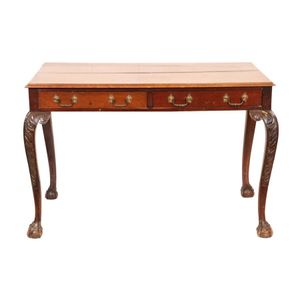19th Century Burr Walnut Occasional Table
You must be a subscriber, and be logged in to view price and dealer details.
Subscribe Now to view actual auction price for this item
When you subscribe, you have the option of setting the currency in which to display prices to $Au, $US, $NZ or Stg.
- Provenance - A term used to describe the provable history of an antique or work of art, and thus an additional aid to verifying its authenticity. Provenance can have an inflating effect on the price of an item, particularly if the provenance relates to the early settlement of Australia, a famous person, or royalty. Less significant are previous sales of the item through an auction house or dealer.
- Cabriole Leg - The cabriole leg evolved from an elongated scroll, curving out at the knee which may or may not be carved, and forming a serpentine shape as it descends to the foot.
First introduced into English furniture in the late 17th century, cabriole legs were widely used during the Queen Anne and early Georgian periods, where they frequently terminated in a pad foot or ball and claw foot. The style has had many imitators since then. The cabriole leg was re-introduced in the mid-19th century, and is commonly associated with the balloon-back dining or drawing-room chairs made in walnut, mahogany or, in Australia, cedar. The Victorian cabriole leg, on the whole, was rather more slender than the earlier form, following the French style, which emphasized the delicacy and daintiness of the chairs they were designed to support. Cabriole legs are sometimes found on windsor chairs, especially those made during the 18th century. - Burr - Burr (or in the USA, burl) is the timber from the knotted roots or deformed branch of the tree, which when cut, displays the small circular knots in various gradations of colour. It is always cut into a decorative veneer, most commonly seen as burr walnut on 19th century furniture.
This item has been included into following indexes:
Visually similar items

A George II grey veined marble topped walnut centre table, circa 1730, with incised carved cabriole legs terminating in pad foot, 104 cm wide, 58 cm deep, 73 cm high

Serving table, early 19th century Chippendale style mahogany with two drawers c1830's length 132 cm, a/f split to top

A George III solid mahogany side table, the rectangular top with thumb-moulded edge, a single drawer to the frieze above a shaped apron, raised on cabriole legs. 83 cm x 52 cm x 74 cm

An impressive Australian large console serving table in the manner of Thomas Chippendale by de Groot in red cedar, burl huon, the cross banded top with canted corners above finely fret carved scrolling wave frieze fronted central long and two short drawers
